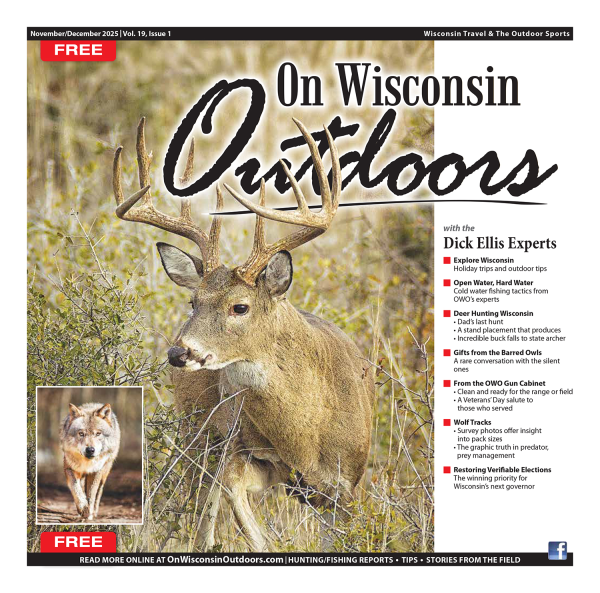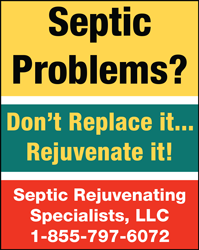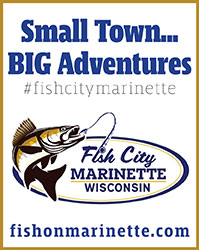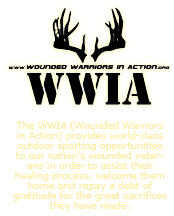DNR Weekly News Update for March 20, 2018
Published - March 20, 2018 by the Central Office
- Lake Michigan fisheries management strategies for 2018-2020 highlight partnerships to enhance fishing for salmon and trout
- Bass fishing changes, transport of CWD positive deer among questions at the 2018 Spring Fish and Wildlife Rules Hearings
- DNR to hold public comment period, public hearing on Foxconn air permits
- DNR to waive fall turkey drawing; licenses on sale now
- Anglers now enjoy a year-round season and five-bag limit for Lake Michigan lake trout
- Bird Survey Organizers Encourage Volunteers to Survey Areas in Need, Attend Regional Workshops in April
- Prescribed burns proposed for many DNR properties in central and southern Wisconsin this spring
- Spring issue of Wisconsin Natural Resources feature DNR 50th anniversary
Lake Michigan fisheries management strategies for 2018-2020 highlight partnerships to enhance fishing for salmon and trout
MADISON -- Fish stocking trucks are starting to deliver the first trout and salmon for Lake Michigan under a new stocking plan that seeks to sustain diverse fishing opportunities and expand partnerships to make sure more stocked fish survive to catchable size and wind up on Wisconsin anglers' lines.
The plan, developed over more than two years of discussion and input from more than 500 anglers, business owners and other stakeholders, calls for stocking Skamania steelhead for the first time in a decade, stocking larger salmon and trout that survive better, and expanding efforts with fishing clubs to place stocked fish in pens in Lake Michigan to get acclimatized and grow bigger before they're released.
DNR Kettle Moraine Springs Fish Hatchery
The plan also calls for DNR to contract with private fish farms to help meet stocking needs, and enhance data sharing with sport and charter anglers to continue improving the information DNR uses to make proactive and innovative management decisions.
"Our Wisconsin waters of Lake Michigan not only have world class fisheries, they have world class anglers, businesses, stakeholder groups, and communities committed to keeping the Lake Michigan fishery strong," says Department of Natural Resources Secretary Dan Meyer.
"With their input, expertise, and discussion, we've created a collaborative plan that embraces partnerships to enhance fishing opportunities and success for all anglers, while sustaining a healthy Lake Michigan fisheries community."

Kettle Moraine Springs Fish Hatchery staff transfer Chambers Creek steelhead from raceways to a stocking truck on March 14 for delivery to Lake Michigan tributaries.Photo credit: DNR
DNR's 2018-2020 plan calls for stocking levels similar to 2017's and remains within the guidance recommended by the Lake Michigan Committee, which is composed of state and tribal agencies on Lake Michigan, says Brad Eggold, DNR Great Lakes District fisheries supervisor.
"We're cognizant of the complex interaction within the prey base," Eggold said. "Our plan stays within Lake Michigan Committee guidelines but also maximizes the bang we get for our investment. We include innovative approaches and partnerships to make sure we are maximizing the survivability of the fish stocked and anglers' success in catching them."
- Chinook salmon stocking numbers remain consistent at about 810,000 fish total a year, recognizing the popularity of this fish and that angler catch rates are highest for chinook. Eight Lake Michigan stocking sites will get more fish (1,800 to 4,200 fish per year) under a reallocation of 25,000 fish from Marinette and Strawberry Creek. Marinette will get 20,000 more brown trout per year, to offset the chinook reallocation.
- The annual lake-wide brown trout stocking target will increase from 356,000 to 376,000 and coho salmon stocking will focus on larger yearlings versus smaller fingerlings for stocking. The number of yearling fish stocked is targeted to increase over previous years, with a target of 400,000 yearlings stocked annually. Wisconsin research indicates that coho stocked as yearlings are nearly twice as likely to be caught by anglers than coho stocked as fingerlings.
- Steelhead stocking targets will increase from 300,000 to 350,000, and lake trout targets will continue to be evaluated, but will remain 300,000 per year for now. DNR partnered with Indiana to bring Skamania steelhead to Wisconsin hatcheries, which will be stocked into Lake Michigan in 2018, and the additional steelhead stocking is expected to occur under a new collaboration with the private aquaculture industry. DNR is developing a Request for Proposals to solicit private aquaculture interests to raise steelhead to supplement DNR stocking into Lake Michigan beginning in 2019.
In addition, the DNR fisheries bureau is: expanding the salmon and trout net pen projects to maximize survivability of stocked fish; committing to working with Sea Grant in collecting additional information from charter and commercial fishers to better inform future management strategies; enhancing outreach and communication by more actively engaging stakeholders in communication initiatives; and exploring enhanced electronic reporting options that will increase the efficiency and accuracy of fishing report data.
Eggold says that DNR staff greatly appreciate the continued involvement, expertise, and collaborative efforts of all Lake Michigan stakeholders. "We will continue to seek creative, constructive, and diverse input to inform management strategies to maintain diverse and sustainable fishing opportunities for current and future sport, commercial and charter anglers."
For more information, contact a Lake Michigan fisheries biologist or search the DNR website, dnr.wi.gov, for "Lake Michigan fisheries."
________________________
Bass fishing changes, transport of CWD positive deer among questions at the 2018 Spring Fish and Wildlife Rules Hearings
MADISON - A continuous season for bass fishing - with harvest only allowed during the current open season - restriction on moving deer that test positive for chronic wasting disease, opening the inland trout season the first Saturday in April, and a new fee to use state wildlife, fisheries and natural areas are among the questions the public can vote on at the 2018 Spring Fish and Wildlife Public Hearing and annual Conservation Congress county meetings.
On Monday, April 9, there will be 72 public hearings [PDF], one in each Wisconsin county starting at 7 p.m. where people interested in natural resources management have an opportunity to provide their input by non-binding vote and testimony to the Department of Natural Resources and the Conservation Congress on proposed natural resources advisory question that may lead to future rule changes.
Among the fisheries management advisory questions are two of statewide interest related to bass fishing. One seeks input on the idea of a statewide, continuous open season for bass fishing. Harvest of bass would only be allowed during the current traditional season. The other proposes establishing alternate size and bag limits for participants in permitted, catch-and-release, bass fishing tournaments.
Local fisheries management advisory questions include:
- Whether the department should initiate a review of longstanding panfish and gamefish size and bag limit regulations on the Mississippi River;
- walleye harvest regulations affecting Koshkonong Lake in Jefferson/Rock counties and the Lake Winnebago system; and
- Lake Superior sturgeon size limit and bank pole fishing regulations on the Winnebago system.
Wildlife management advisory questions include on asking whether deer harvested in a CWD-affected county could only be transported within that county or to an adjacent CWD-affected county to minimize the risk of moving CWD prions along with carcasses to areas of the state that have not had CWD-positive test results.
Other wildlife management questions include:
- a proposal to change the closing time of certain wildlife refuges to the end of the waterfowl season to would allow recreational users earlier access to the refugees; and
- moving the close of pheasant season daily shooting hours on public properties stocked with pheasants from 2 p.m. to noon on weekdays from the third day of the pheasant season through November 3 to give wildlife staff more time and flexibility to stock while removing hunting pressure on the birds until the next morning.
The results of voting on the DNR proposed questions will be used by the department in the development of future policies and rule proposals. The department will hold hearings on any rule change proposals that advance at the 2019 spring hearings.
This year the Conservation Congress will seek public input on 36 advisory questions on a range of topics, including:
- opening the inland trout season statewide on the first Saturday in April
- returning to a three-zone mink and muskrat season framework;
- allowing the unrestricted harvest of white perch on Lake Superior;
- changing the requirements for obtaining a Wisconsin Guide License.
"Conservation Congress advisory questions generally originate from citizens' ideas." said Larry Bonde, Chairman of the Wisconsin Conservation Congress. "If resolutions presented at the county level meetings are supported, the resolution is advanced to one of the congress' advisory committees and the District Leadership Council for consideration. If the proposal advances through the committees and council, it is forward to the DNR and Natural Resources Board for consideration as a future rule change.
"Each year, there are over 200 resolutions submitted locally. Not all pass, but the ones that do have the potential to become a rule, policy or legislative change in the subsequent years," Bonde said. "It is a true grassroots process that empowers the citizens of this state to shape natural resources policy."
The State Natural Resources Board is also seeking input on a number of advisory questions, including a proposal for a $5 annual fee for all users between the ages of 16 and 64 of state fishery, wildlife, natural areas and leased public hunting grounds and dedicating that money to directly support fish and wildlife habitat management and infrastructure on those properties.
Other board questions include:
- eliminating the group deer hunting law so that the only person who can fill a tag is the hunter that had been issued the deer harvest authorization; and
- adjusting the length of the crossbow season, for those who are not disabled or elderly.
To view the 2018 spring wildlife and fisheries questionnaire package [PDF] or for information about the process search the DNR website, dnr.wi.gov, for "spring hearings."
County Conservation Congress elections
During the Conservation Congress county meetings, county residents have the option to run for a seat on the Conservation Congress and to elect delegates from their county to represent their views regarding natural resources issues on the Conservation Congress, the citizen advisory body to the Natural Resources Board and DNR. Also, individuals have the opportunity to bring forth new conservation issues of a statewide nature to the attention of the Conservation Congress through the citizen resolution process.
________________________
DNR to hold public comment period, public hearing on Foxconn air permits
MADISON - The Wisconsin Department of Natural Resources is seeking public comment on air permit drafts for the Foxconn liquid crystal display manufacturing facility proposed for construction in Racine County.
The department made available for public comment the applications, draft permits and analysis documents for four air pollution control permits covering the Foxconn facility. To view the documents search the DNR website, dnr.wi.gov, for keyword Foxconn. The DNR will accept public comments through April 16, 2018.
The DNR will also hold a public hearing on April 3 at 7 p.m. at the SC Johnson iMet Center, 2320 Renaissance Boulevard, in Sturtevant. Beginning at 6 p.m. the public may meet with DNR staff and ask questions about the project and the air permit review process prior to the formal public hearing.
Written comments may be sent to jonathan.wright@wisconsin.gov or to Wisconsin Department of Natural Resources, Northeast Region Air Program, Oshkosh Service Center, Attn.: Jonathan Wright, 625 E. County Road Y, Suite 700, Oshkosh, WI 54901-9731.
________________________
DNR to waive fall turkey drawing; licenses on sale now
MADISON - New this year, fall turkey hunters will no longer be required to apply or compete in a drawing for fall turkey harvest authorizations. Instead, one fall turkey harvest authorization will be issued at no additional cost with the purchase of a fall turkey or conservation patron license. Customers will need to specify their zone of choice when purchasing their license.
In addition to the fall harvest authorization issued with the purchase of a license, bonus fall harvest authorizations will be sold over-the-counter on a first-come, first-served basis. Select turkey management zones will have a set number of bonus authorizations available for $10 apiece beginning in August. Bonus authorization levels are determined after looking at turkey harvest and population data, as well as hunter feedback and harvest authorization sales, within each zone.
Wisconsin has seen a decrease in fall turkey harvest over the past decade. DNR surveys indicate the lower harvest is due to reduced hunter participation and effort, and not a reduction in the turkey population. In the fall, more people are hunting turkeys opportunistically while pursuing other species, rather than exclusively hunting for turkey.
The reduced harvest and hunter effort has led wildlife managers to believe a competitive drawing is no longer necessary for the fall season. The DNR will continue to monitor harvest and population data to ensure continued success of Wisconsin's wild turkey management program.
For more information on the fall turkey season and turkey hunting in Wisconsin, visit dnr.wi.gov and search keyword "turkey."
________________________
Anglers now enjoy a year-round season and five-bag limit for Lake Michigan lake trout
MADISON - The lake trout fishing season on Lake Michigan is now open year-round and the bag limit is five fish per day under rules effective March 17, 2018.

Lake Michigan anglers can now enjoy a year-round season and a bag limit of five lake trout under rules effective March 17, 2018.Photo credit: Jason Richter
The five-bag limit and continuous open season make regulations for lake trout consistent with season structure and bag limits for other Lake Michigan trout and salmon, according to Brad Eggold, Great Lakes district fisheries supervisor with the Wisconsin Department of Natural Resources.
The rules, adopted Feb. 28 by the state Natural Resources Board and effective upon publication March 17, seek to allow increased sport harvest opportunities for lake trout and maintain a sustainable population while pursuing restoration goals.
The increased bag limit reflects enhanced lake trout populations in certain areas of Lake Michigan and responds to anglers' repeated requests to allow increased fishing opportunities for lake trout. Anglers made the requests over the course of 2016 and 2017 during DNR's extensive stakeholder outreach and engagement to help determine the fish stocking plan for Lake Michigan trout and salmon from 2018-2020.
The rule establishes a sunset clause in 2021 reverting the season framework back to a two-fish bag limit with fishing allowed from March 1 through October 31. However, that sunset provision will be repealed through additional rulemaking if harvest information continues to show that a sustainable fishery can be maintained with the five fish bag limit, Eggold says.
For more information regarding lake trout fishing on Lake Michigan, search the DNR website, dnr.wi.gov, for "fishing Lake Michigan."
________________________
Bird Survey Organizers Encourage Volunteers to Survey Areas in Need, Attend Regional Workshops in April
ASHLAND, Wis. - With just two of five breeding seasons left to go, organizers of a comprehensive survey of birds that nest in Wisconsin have identified more than 300 locations where volunteers are needed to help gather information for the survey, known as the Wisconsin Breeding Bird Atlas II.
"This is a perfect time to choose a location where you can help look for breeding birds and report them," says Nick Anich, atlas coordinator and a conservation biologist with Wisconsin Department of Natural Resources. "The bulk of bird species will nest in June and July but some resident birds are getting started already, and it's a good time to head out to a location near you and poke around, explore some habitats and see what's out there."

Volunteers for the Wisconsin Breeding Bird Atlas survey report birds engaged in nesting behaviors. An unusually high number of red crossbills moved into Wisconsin last fall, and early breeders can now be found building nests and sitting on eggs.Photo credit: Ryan Brady
Participating volunteers are already submitting observations from around the state of early breeding bird species like great horned owl, bald eagle, red-tailed hawk, common raven, red crossbill, and pine siskin sprucing up their nests or sitting on eggs.
The goal of the Atlas is to help document the distribution and abundance of all birds breeding across the state. This information will help scientists, land managers, and birders get a better understanding of the population size, preferred habitat, and range of each species and how those have changed since the last Atlas survey 20 years ago.
The survey splits Wisconsin into nearly 7,000 blocks of land, equally distributed throughout the state, with about 1 in 6 of these blocks of highest priority. These blocks must be fully surveyed by the time fieldwork is completed in 2019 to allow for good comparisons with data collected in the same locations 20 years earlier, Anich says. Organizers are urging birders to visit wiatri.net/projects/WBBA/WBBAmap.cfm (exit DNR) to register to become the principal atlaser for one of the remaining open blocks.

Bird lovers can help complete a comprehensive survey of birds that nest in Wisconsin by volunteering to record their observations in those locations with red and yellow blocks. Locations with red blocks are particularly in need of helpPhoto credit: Nick Anich
Even with 1,500+ volunteers having participated to date, there are many easy-to-reach blocks still available, especially in the northern two-thirds of the state, says Ryan Brady, a DNR conservation biologist and science lead for the survey.
"Open blocks in Wisconsin's northern and west-central counties commonly host more than 85 breeding species, and can offer special opportunities for volunteers looking for warblers, boreal specialties, or just quality time outdoors," Brady says.
Volunteers interested in rural counties of central Wisconsin have plenty of exciting open-country species to look for as well, Brady says. Whooping crane, greater prairie-chicken and Henslow's sparrow are among them.
Atlas Regional Kickoff Workshop Dates and Locations
Interested volunteers are encouraged to attend a regional workshop to learn more about the Atlas survey:
- Western Region - April 14, 9 a.m.-12:30 p.m.: National Eagle Center, Wabasha, MN
- Eastern Region - April 21, 12-4:30 p.m.: Sturgeon Bay Library, Sturgeon Bay, WI
Workshops are free but registration is required. For details and registration, visit http://wsobirds.org/ atlas-2018-regional-kickoff-workshops
The Wisconsin Breeding Bird Atlas II also has a number of field trips and smaller training events planned for spring and early summer months, all skill levels are welcome. Visit wsobirds.org/atlas-events (exit DNR) for details.
________________________
Prescribed burns proposed for many DNR properties in central and southern Wisconsin this spring
MADISON -- Wisconsin Department of Natural Resources staff plan to conduct prescribed burning on several department-managed properties in the west central, southeast, and southern Wisconsin this spring.
To view a list of proposed spring 2018 prescribed burns on DNR properties and more information regarding prescribed burning in Wisconsin, visit dnr.wi.gov and search keywords "prescribed burning."
Prescribed burning is part of an ongoing effort to preserve and restore the landscape found within DNR properties throughout Wisconsin. These burns reduce leaf litter, improve wildlife habitat, redistribute nutrients and help control invasive species.
The window for conducting prescribed burns is relatively small, due to special weather conditions required. The moisture level of groundcover, wind speed and direction, and relative humidity must be just right for a safe and successful burn. Please note that planned burns may or may not occur, based on these factors.
Prior to any prescribed burns, trained personnel assess the area to determine wind direction and speed, relative humidity, grass moisture and safety requirements. Qualified personnel control fire behavior using comprehensive planning and specialized fire equipment. Local police and fire officials are notified when and where burns will take place.
________________________
Spring issue of Wisconsin Natural Resources feature DNR 50th anniversary
MADISON - The Spring edition of Wisconsin Natural Resources magazine is on its way to readers, and the first issue of 2018 focuses on a celebration: It's the Department of Natural Resources' 50th anniversary. The agency and the Natural Resources Board that guides it were created in 1968 by a merger of the Wisconsin Conservation Department and Resource Development Department. The Spring cover story, "A DNR is born," commemorates the event, while coverage in the magazine throughout the year also will mark the occasion.
Another anniversary is celebrated in this issue as well: This is the 25th year for field trips offered by the Natural Resources Foundation of Wisconsin. "25 years of adventure" lauds the long-running and popular program and includes information on how to sign up for these statewide outings that run all year long.
An update on the DNR's pheasant-rearing facility in Poynette is included in the Spring issue. "Hatching success at the State Game Farm" highlights upgrades that have modernized the facility, which hatches about 250,000 pheasant chicks each year to stock lands for hunting and birding.
In keeping with the magazine's historic theme, a story titled "Natural leader, nature champion" profiles Gordon A. Bubolz, a business executive and Republican state legislator in the 1940s and '50s who advocated for land preservation. High Cliff State Park and an Appleton nature preserve named for Bubolz are among the spots attributed to his work.
Two stories take readers to special places outdoors. "Wander these little wild spaces" explores the Milwaukee area's many fields of green, while "Rooted in the past, a sanctuary grows" visits Faville Grove, a 675-acre parcel of prairie, woodlands, wetlands and savanna in Jefferson County. A fun short piece, "Porch-sitting makes way for ducklings," about a nesting box and the badling of little wood ducks using it rounds out the magazine's Spring stories.
Wisconsin Natural Resources - now publishing quarterly in Spring, Summer, Fall and Winter - has adjusted its regular features slightly. A letter from DNR Secretary Dan Meyer has been added to Page 2, where he checks in with seasonal updates. The back-page feature, formerly called "Wisconsin, naturally," has been renamed "Outside in Wisconsin" to reflect a broader reach beyond State Natural Areas and include all state properties. The Elroy-Sparta State Trail is in the Spring spotlight.
"Reader's Write" letters and feedback are included in the magazine as always, and the "Back in the day" feature remains, too, moving to the inside back cover. In a nod to DNR's 50th anniversary, the current "Back in the day" piece on fishing for walleye is excerpted from the 1968 Conservation Bulletin.
Fishing also is highlighted in the annual Wisconsin Fishing Report, a Spring issue insert, with all the information needed for a successful fishing season.
Wisconsin Natural Resources magazine is available for $8.97 per year. Subscribe at 1-800-678-9472 or online at wnrmag.com.












